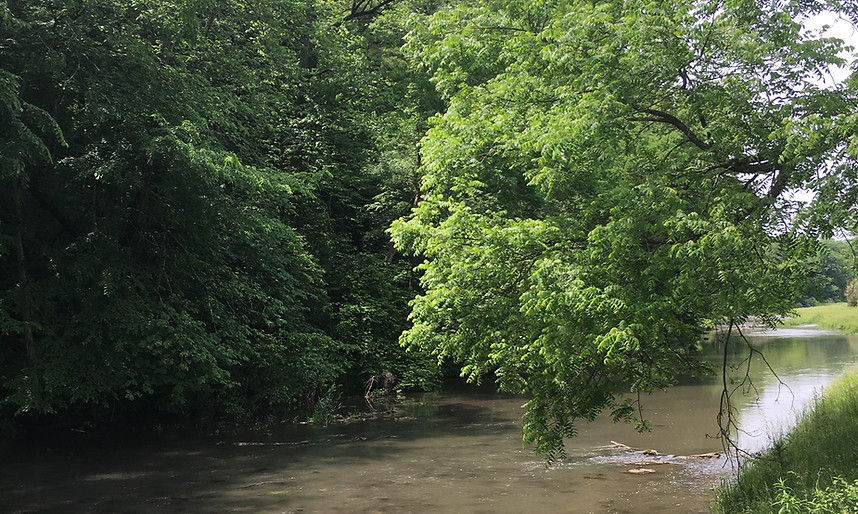
THE
WATERS
Look at any map I've got, and you'll find marks in the margins. Sometimes the marks are descriptions (the words of a sign, short reminders of turns or pull-offs, mistakes to remember not to make again). Sometimes they're depictions (drawings of trees, of bridges, of churches, houses or hills). They seem as if they're meant to get me there again, but they're seldom needed for that. More, they're reminders of what I can never revisit: the moment of discovery.

05: THE NAME
Sometimes, never having known of a thing’s existence, an image of it floods to mind with the mere evocation of its name. I came to know this stream that way. I knew of it for years before I ever set foot on its banks. Without having laid eyes on its water, easily stained in the runs, but clear in its riffles and turquoise in many of its deep pools — imagination had filled in the open mindspace it flowed through with striking clarity. I had a picture, too, of its wooded banks and a valley surrounded by high, forested hills. Waist-deep in the flow of my dreams, I could see casting into the midday sun, a ribbon of open blue stretched out above my head. Why it took so long to make it another forty-five-minute drive from the streams I’d fished for a decade or more is one of those unexplainable mysteries of life. There was just always so much water between home and the banks of Mississippi. I had not been to the coulees or to the Kickapoo yet either. Just so many miles of stream and such precious little time. Then came a Sunday afternoon in October when my trusted fishing buddy and I sat on his back patio drinking whiskey, while our wives talked in the kitchen. Windows open, we could hear their chatter flutter, muddled on the wind. Golden light drenching the colors of the leaves and the last of the Fall shine on the bark of the trees. Realizing that Wisconsin’s season was now closed to us, but that our first weekend to fish together since the onset of Spring was the one ahead of us — I moved my fingertip west on the map, to territory full of spring creeks unknown to both of us. Iowa. I dared not even speak its name as I circled the stream on the map. He nodded, “Looks like we can camp there.” Less than a week later we lifted off the western edge of Wisconsin and crossed the sparkling Mississippi into a whole new dimension of the Driftless. A half mile past that old river’s western bank, the highway sails up around a hillside, and a dirt road cuts down and away, into the valley along the stream. First sight of it is where it runs along the road, down a sheer bank about 25 feet or so, off the driver’s side. The dirt path is about a car and half wide for a good stretch, until you get to the only house in this part of the valley, a sweet location right on a prime run. The rest of the way it’s campground. There’s a huge open grass pasture off the passenger’s side, then railroad tracks, then two small pockets of more rustic bankside sites. We pulled in to a spot in the corner, big enough for both our tents, with a fire pit and a picnic table. A nice, long run beside us. It being off-season, there was no one else there. We pitched camp, then geared up and hiked off in search of shadows. Everything about this place has always been mystical to me. Probably because this stream was born in my dreams. But since first laying eyes on it, I have felt connected to it. That trip was the first we ever kept anything. We said one each for dinner, but it had to be regulation, naturally, and we had to dispatch it ourselves. Not a problem once you’re used to it, but for a couple of strictly catch-and-release fly fishermen, it was not the simplest of tasks. We did, though, and cooked them in a cast iron pan over a campfire. I have had horrible, gray days where the water was chocolate and nothing was happening. I have had glorious, bright-shining days where the water danced and the trout were tugging constantly at the line. I’ve hiked upstream and down, fished here alone and with new and old friends. And that night, that first night, not realizing we had pitched right down the seven-foot slope from the tracks...or that the trains ran through the campground at three in the morning, all steel-on-steel sound and fury bouncing off the canopy above, shaking the ground beneath our tents and drowning out the entire natural world for a solid five minutes. It makes you feel alive, and, once it passes, is replaced again by the gentle turning of current and slurping of fish feeding on moonlit mayflies. Bloody Run.



